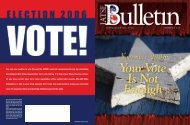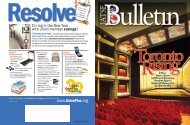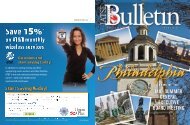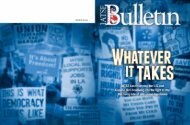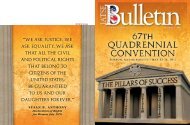Fourth Quarter 2008 - IATSE Local 8 Philadelphia
Fourth Quarter 2008 - IATSE Local 8 Philadelphia
Fourth Quarter 2008 - IATSE Local 8 Philadelphia
- No tags were found...
You also want an ePaper? Increase the reach of your titles
YUMPU automatically turns print PDFs into web optimized ePapers that Google loves.
In 2001, members of <strong>Local</strong> 839 collaborated on a comic bookto aid in the Guild's organizing effortsTop Image: Eric Goldberg (top); Mark Kausler (middle); TomSito (bottom)Bottom image: Ronnie Del Carmen (top); Mike Ploog (bottom)Coloring (all images) by Narry Khangchuckles, “because the computer is perfect for a hyper-realapproach; it wants to put all those details back in.”While Disney artists say drawing skills are still essential inthe age of digital animation, they can only soar as high astheir software will allow. CG Supervisor Mike King, whobegan at Disney in 1995, working tech support on TheHunchback of Notre Dame, and then later in CG productionfor Pixar on Toy Story 2, has been working on several unannouncedDisney projects to create not only a smaller, morecost-efficient CG footprint, but one that truly puts engineeringat the service of the artist, and not the other way around. “Youcan make pretty pictures off-the-shelf with software like Mayaor Lightwave,” King remarks. “But you try to do 2,000 shotsand those packages break down. The amount of collaborationthat has to happen between all the different disciplines to getDisney quality imagery up on the screen is huge, so we haveto write a lot of our own code. Everything from the leaves ontrees to the way a character’s hair is shaded looks different ina Disney film, and software is integral to that process.”LET US ALL BASK IN TELEVISION'SWARM GLOWING WARMING GLOWAs noted, the history of the Hollywood animation industryhas been a series of cresting waves and ebbing technologicaltides, and since inception <strong>Local</strong> 839 members havebeen trying to ride each new wave to the sand. Many havefared well, like the many animators who retrained in CGI fora now “paperless” industry. Others, uncomfortable with thedigital workflow, repurposed their skills, i.e., trading layoutdrawings on animated features for hand-drawn storyboardwork in live action. Some union animators, like directorMark Kirkland, never had to make a choice. Kirkland, athree-time Emmy winner, has worked continuously on TheSimpsons for nineteen years! He holds the show’s record fordirecting the most episodes at sixty-two.“I was at CalArts in the mid-70s,” Kirkland explains overlunch at The Hill Street Café in Burbank, “and Ed and I(Simpsons’ colleague Ed Ghertner) were both in layoutstudying under the great Disney art director Ken O’Connor.[O’Connor’s many Disney creations include the “marchingcards” in Alice in Wonderland” and the “dancing hippos” inFantasia.] My first industry job was at Hanna-Barbera, whereI worked on many different styles of shows – Scooby Doo,The Flintstones, Superman, you name it. Moe Gollub, whosecareer went all the way back to Snow White and Bambi, wasmy mentor. I also took figure-drawing classes from Moe atthe union. We had a saying that at Disney the animatorswere king, but in television it was the layout artist. Stagingshots was always my favorite part of the process and workingat Hanna-Barbera, with all of the time and budget constraints,taught me how to make every drawing count.”It’ s an interesting challenge because[television animators] are going to have tostart thinking more cinematically instead ofjust head shots and limited depth of field.Kirkland says the main difference between animated featuresand television is the volume and speed of work. It typicallytakes two years to create a 90-minute animated feature,versus the 22 half-hour episodes of The Simpsons that areproduced in a single season. At BRC Imagination Arts, Kirklandproduced a short for Disney called Back to Neverlandthat detailed how the company created its animated features.The next year he directed and storyboarded an IMAX-sizedanimated film for a World’s Fair in Osaka, Japan. “I was 33years old with a family to support when The Simpsons beganlooking for directors,” Kirkland recalls. “David Silverman[supervising director and producer] asked me if I had everworked in Saturday morning TV, and I said I’d been a layoutsupervisor at Hanna-Barbera, and he said that’s perfect!”Since he first came on-board, Kirkland says creator MattGroening always told his directors to seek out “half-gags”,opportunities that add extra humor, even if it only generatesa smile. Kirkland describes one such episode early in hisSimpsons career where the script called for Homer to say“tomorrow I’m going to punch Lenny in the back of thehead.” “It wasn't called for in the script, but I literally stagedLenny at the power plant, innocently sipping hot coffee,then Homer’s hand came into frame and hit him in the backof the head causing Lenny to do a spit take,” Kirklandrecalls smiling. “The show was long and we were lookingfor scene cuts. I called up the producer to confess that I hadadded a gag and he ended up cutting their own materialand keeping my gag in!”“Happy Place”illustration byTom Sito,Courtesy<strong>Local</strong> 839The hang-loose, familyfriendlyproduction offices ofThe Simpsons occupy a special place in the animation world.The show’s style of animation is a “hybrid”, blending the 2Dcolor palette of television with a single-camera approachthat’s typical of live-action filmmaking. Visitors to the Burbankfacility will see rows of artists working at traditional animationstands, complete with disks and light tables. But onlya few years ago, each episode moved over to digital painting(rather than with ink and paint on acetate cels); the show’sfront end is now transitioning to the computer as well. Evenafter 20 years (!), staying true to The Simpsons’ iconic characters,through staging and layout, remains Kirkland’s biggestchallenge. That can be as profound as satirizing classicmovies like Citizen Kane, or as simple as showing Homerwith his arms full of groceries and using his hip to close thedoor, a la Jackie Gleason. “The Simpsons style of comedy is amelting pot: low-brow, high-brow, slapstick, sit-com, satireand even pathos, and as a director, I’m mindful of all thatstuff,” Kirkland adds, “while still being an effective projectmanager. A typical episode has 20,000 to 30,000 drawings.”Character layout artist Ed Ghertner came to The Simpsonsin a relief capacity, after much of the main staff waspulled away to work on The Simpsons Movie. His backgroundincludes long stints at Disney Feature Animation,including six years on a single film, Atlantis. His broadexpertise with layout (he started when the multi-plane camerawas still in use) gives him a big-picture look on TV ani-18 Official Bulletin<strong>Fourth</strong> <strong>Quarter</strong> <strong>2008</strong> 19








